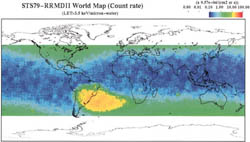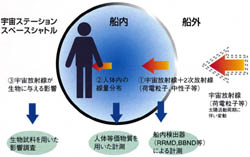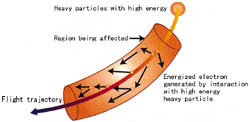|
Space Radiation Environment Measurement |
|
 |
Details of the passed experiments |
 The
construction of the International Space Station (ISS) is going to be started
from late 1998 and the experiment module of Japan will be attached to the ISS
in 2001. Six astronauts including Japanese astronaut are going to stay in the
ISS and conduct various activities including space experiments which utilize
microgravity environment.
The
construction of the International Space Station (ISS) is going to be started
from late 1998 and the experiment module of Japan will be attached to the ISS
in 2001. Six astronauts including Japanese astronaut are going to stay in the
ISS and conduct various activities including space experiments which utilize
microgravity environment.
In the ISS since the duration of stay for one astronaut will be as long
as several months, it becomes obvious that the space environment such as
microgravity and space radiation will be major concerns for the astronauts.
To study these effects, the National Space Development Agency of Japan
(NASDA) picked up space radiation as a research target. Utilizing the Space
Shuttle NASDA is developing space radiation monitoring technology and also
accumulating fundamental data in order to study the radiation risk for
human subjects and its protection.
As the first step of the International Space Station (ISS) program, NASA's
Space Shuttle and the Russian space station Mir will rendezvous in space.
From 1995 through 1998, nine cooperative flights were planned. The purposes
of these flights are to transfer crew and supply cargo from the Space Shuttle
to Mir, and to perform scientific researches in order to learn mitigate
the risks of ISS construction and operation. The Space Shuttle docks with
Mir in the same orbit as the ISS, so experiments can be conducted under
the same space radiation condition. NASDA has planned to utilize four opportunities
out of the nine flights to accumulate space radiation environment data.
The experiments have been conducted previously on STS-79,84 and 89. This
STS-91 will be the last of these series.
In space radiation monitoring charged particles (particles with charge
such as electron, proton and heavy atoms with high energy) inside the Space
Shuttle and neutron are the another target of the observation. For charged
particle monitoring, the Realtime Radiation Monitoring Device (RRMD) will
be used.
On the first opportunity STS-79, the measurement focused on the High LET
(Linear Energy Transfer) charged particles which could affect material
and human body inside the cabin. On the second opportunity of STS-84, the
measurements focused on the Low LET charged particles. Through those two
opportunities NASDA confirmed the fundamental technology of the monitoring
to cover whole range of LET in the ISS orbit. On the third opportunity,
STS-89, the measurement focused on a region called the South Atlantic Anomaly
where the most of the proton events happen on the orbit by recording all
data without restrictions of data transmission. By this method detailed
South Atlantic data were successfully obtained.
RRMD data monitored during the previous three flights were transmitted
to Japan in real time. Those data were used for the preliminary research
of space radiation environment forecast. The data were compared with other
data sources monitored by such as Geostationary Meteorological Satellite.
In addition to this, during the third opportunity, STS-89, Neutron monitoring
device Bonner Ball Neutron Detector (BBND) was used for the real time mapping
and spectrum monitoring of neutron for the first time in the Space Shuttle.
In addition to the physical measurements, Biological experiments are simultaneously
conducted to understand biological process under the space radiation or
microgravity environment. On orbit, biological system has to receive a
unique environment not only space radiation but also microgravity. Biological
experiments have been performed focussed on the radiation damages of DNA
and its repair process in living organism. The experiments try to find
what kind of differences occur due to microgravity environment in recovering
damaged DNA by radiation.
 |
Technology development for monitoring Space Radiation Environment |
The technology developed for the Space Radiation Environment Monitoring
allows us to acquire precise space radiation data. The effort will be applied
for radiation protection and risk management on the Space Station being
developed.
- Inner cabin space radiation monitoring device
Inside the cabin, we have to consider the secondary radiation which is
generated by a hit of primary space radiation. The major components of
the secondary radiation are charged particles such as electron, proton,
high energy particle, and neutron. In order to monitor the whole spectrum
of radiation, charged particle monitoring by RRMD and neutron monitoring
by BBND are essential.
- Personal dosimeter
In order to monitor and estimate radiation risk of each astronaut, a compact
and light weighted personal dosimeter is inevitable. In order to develop
such a device, various types of dosimeter were to monitor space radiation,
and their data will be compared with those of RRMD. The study is to determine
the most suitable combination of dosimeters for personal monitor.
- Network for real time dosimetry
In order to collect and transfer the monitored data in real time to analyze
space radiation, data communication network will be set up and operated
during mision.
 |
Accumulating fundamental data of space radiation |
As shown in the figure, data will be accumulated in three categories ;
(1) Space radiation environment in the cabin, (2) Radiation dose distribution
inside human body, and (3) Biological effect induced by space radiation.
| 1. |
space radiation environment in the cabin |
|
Data of space radiation environment in the cabin are obtained
by RRMD and BBND. In conjunction with data recorded under different solar
activity condition the relation between solar activities and radiation
environment in the cabin are being studied. Also, for developing space
weather (space radiation environment) forecast capability in the future
those data will be studied with various space environment data obtained
by Geostationary Satellites. |
|
| 2. |
Radiation dose distribution inside the human body |
|
Radiation dose distribution of human organs are being
investigated in relation to the space radiation environment in the cabin.
By analyzing data obtained by this investigation the dose distribution
in each organ is expected to be clalified. |
|
| 3. |
Biological effect induced by space radiation |
|
- Effect of space radiation
What kind of processes inside the living cells been taken place when
exposed to space radiation? A detailed study will be carried out by using
well defined biological systems such as yeast.
- Synergystic effects between space radiation and microgravity
The results of previous space experiments indicate that there is a possibility
of space radiation effects on living organism being enhanced or suppressed
by microgravity. In order to clarify this phenomenon, biological system
such@as radiation resistant bacteria will be used to study the effects
of mirogravity on DNA repair process from the damage.
|
 |
|
|
 |
What Space Radiation is? |
| 1. |
It is originated from the solar flare or the explosion of a supernova. |
|
- Space radiation flux varies in an eleven year period due to solar activities
and the amount of solar flare.
|
|
| 2. |
Contains high speed atomic nuclei |
|
- An extremely high speed atomic nuclei such as iron or carbon.
- The thick atmosphere shields the most of them so that no such radiation
arrive on the ground.
- When it passes through material, part of the energy is given to the
material and initiate the effects around the trajectory.
|
|
 |
Last Updated : June 4, 1998


 The
construction of the International Space Station (ISS) is going to be started
from late 1998 and the experiment module of Japan will be attached to the ISS
in 2001. Six astronauts including Japanese astronaut are going to stay in the
ISS and conduct various activities including space experiments which utilize
microgravity environment.
The
construction of the International Space Station (ISS) is going to be started
from late 1998 and the experiment module of Japan will be attached to the ISS
in 2001. Six astronauts including Japanese astronaut are going to stay in the
ISS and conduct various activities including space experiments which utilize
microgravity environment.
